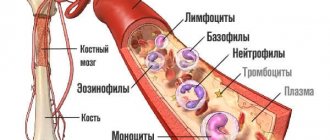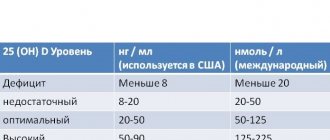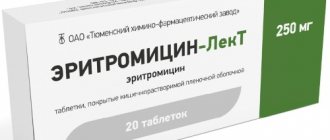Normal ESR levels in the blood of men by age: table
For adult men who do not have health problems, the ESR norm is presented in the table.
| Man's age | Averaged minimum normal values in mm/hour | Averaged maximum normal values in mm/hour |
| 15-20 years | 1 | 11 |
| 30-50 years | 2 | 16 |
| Up to 60 | 5 | 14 |
| Over 60 | 20 | 36 |
If the ESR in men is normal, this is evidence of the absence of serious inflammation in the body. But this indicator is not the basis for diagnosis; additional examination methods are required, taking into account the total number of white blood cells, changes in the leukocyte formula, and C-reactive protein. ESR also depends on the quantity and quality of red blood cells.
Men have several degrees of ESR deviation from the norm:
- the first is an insignificant difference in the results of the UAC, possibly even a false positive, which implies retaking the test;
- second – exceeding the norm by 20 units or more, which indicates the initial stage of inflammation of an infectious nature or associated with general malfunctions of the body, requires control;
- third - ESR reaches 60 mm/hour, which warns of the development of necrosis and generalization of inflammation, treatment is necessary immediately;
- fourth – ESR is more than 60, which happens with a complex genesis of the disease, including a malignant one.
Note that in adult men, an ESR below 10 mm/hour is an almost complete guarantee of the absence of inflammatory processes in the body.
Study
To determine ESR, blood in the laboratory is mixed with an anticoagulant - a substance that prevents blood from clotting. To find out at what rate red blood cells settle, you need to wait until the process of separation of red blood cells from plasma and other blood elements takes place. The specific gravity of red blood cells is higher compared to the mass of plasma and other elements, so they slowly sink to the bottom of the test tube.
To conduct the study, 2 methods are used:
- Panchenkova;
- Westergren.
The ESR value is determined in mm/hour - this is the distance to which red blood cells were able to settle over a set period of time. In the analysis form, this indicator is written as ESR or ESR; previously the term ROE was also used.
How to prepare for analysis
A complete blood count is done to determine the erythrocyte sedimentation rate. You can minimize the likelihood of obtaining unreliable results if you understand the rules for preparing for the study.
You need to donate blood on an empty stomach, at least 8 hours must have passed since your last meal.
It is not advisable to take medications in the morning before the examination. It is not recommended to smoke an hour before donating blood. On the eve of the examination, you should limit physical activity and avoid stress.
Important information: Norm of leukocytes in the blood of women by age (table)
Before taking the test, you are only allowed to drink water.
Panchenkov method
To conduct a study using the Panchenkov method, you need capillary blood, which is taken from your finger. It is mixed with an anticoagulant in a ratio of 1:4, poured into a special test tube, which has the shape of a tube with a scale from 1 to 100.
To determine ESR, it is installed vertically. The results obtained are assessed after 60 minutes. The distance at which red cells are visually separated from other blood elements is an indicator of ESR.
Determining the rate at which red blood cells settle using the Panchenkov method is used in post-Soviet countries, including Russia. The Westergren method is considered more accurate.
Westergren method
WHO recommends using the Westergren method to determine ESR. To determine the sedimentation rate of red cells, a scale of 200 divisions is used, which are located 1 mm apart. But to carry out an analysis using the Westergren method, venous rather than capillary blood is required.
The technique of performing the study does not differ significantly. Blood is mixed with an anticoagulant and poured into a test tube with a scale. Results are assessed within an hour.
Natural causes of increased ESR in the blood in men
All reasons for the increase in ESR in men are conventionally divided into physiological, pathological and due to long-term use of hormones. About 10% of the male population have a priori slightly increased ESR - this is a variant of the physiological norm. In addition, physiological factors include aging of the body, physical activity, including sports, overeating, alcohol, smoking, and climate. You can also safely include allergies and the recovery period after abdominal surgery.
Taking hormones is a separate issue because it is neither pathological nor normal. This is simply a fact that must be taken into account.
Reasons for deviations
If the results of the obtained tests show that the ESR in men is higher or lower than normal, then it is necessary to look for a disease that provoked an increase in the erythrocyte sedimentation rate.
Depending on the results obtained, the degree of deviation is determined:
- 1st degree - the indicators do not fit into the norm by 1 mm/hour, this is an acceptable deviation;
- 2nd degree - increase to 15-30 units. observed during the development of an acute infectious or other pathological process in the body;
- 3rd degree - ESR is increased to 30-60 units, this level will be with a pronounced inflammatory or necrotic process;
- 4th degree - the level of ESR in the male body exceeds 60 mm/hour, this indicates a threat to the patient’s life.
But normal ESR values may vary in different laboratories. Therefore, when assessing the results, it is better to focus on the reference values indicated on the issued form.
Why is it rising?
A high level of ESR indicates the development of a pathological process in the body. The most common reasons for increased ESR are:
- infectious diseases - viral, bacterial, fungal;
- malignant neoplasms;
- kidney diseases - glomerulonephritis, nephrotic syndrome, pyelonephritis;
- rheumatological diseases - rheumatism, inflammatory pathologies of connective tissue, vasculitis;
- endocrine pathologies, metabolic disorders;
- some types of anemia.
Common reasons that cause ESR levels to be higher than normal include allergies and poor diet. After operations, the rate at which red blood cells settle may be higher than normal for a long time. In such a situation, it is allowed for the speed to be at the level of 21-24 mm/hour.
Important information: How are platelets indicated in a general blood test?
An ESR of 45 may indicate that the man has suffered a heart attack.
An elevated ESR does not always mean that a pathological process is going on in the body. Increasing this indicator to 26-28 units. is a normal variant in patients after burns. Don’t worry if after a fracture or injury the level rises to 25-29 units. An increase is possible due to intoxication of the body. When receiving the indicated indicators, it is advisable to retake the analysis.
False parameter changes
When assessing results, doctors look not only at the ESR level, but also at other blood parameters. Speed deviations from the norm can be caused by external factors. One of the reasons for the increase in the indicator may be the use of hormonal drugs.
The height to which red blood cells settle is determined by laboratory assistants.
Therefore, the possibility of error cannot be ruled out. Before starting a comprehensive examination, it is better to retake the general analysis.
A decrease in values is possible in people who are undergoing treatment with glucocorticosteroids. ESR will be below normal in fasting men and patients who are vegetarians.
Reduced value
A reduced red blood cell sedimentation rate indicates the following problems:
- progressive muscular dystrophy;
- violation of water-salt balance;
- neurological pathologies;
- dysfunction of the liver, kidneys;
- bone marrow diseases, in which the concentration of red blood cells in the blood increases;
- changes in the shape and size of red blood cells;
- increased blood viscosity.
Low ESR does not always indicate pathology. A lower value may be a variant of the norm.
Reasons for the decline
If laboratory tests show a decrease in ESR, then we are talking about:
- neuroses;
- epilepsy;
- erythremia;
- hepatitis, cholecystitis;
- disorders in the coagulation system;
- pathologies in the hematopoietic system: anisocytosis, sickle cell anemia, Minkowski–Choffard syndrome;
- taking medications: salicylates, NSAIDs;
- violations of water-salt metabolism;
- muscular dystrophy;
- vegetarianism;
- surgical interventions.
Why is the ESR level low?
A low ESR value can occur under the following conditions:
- Neurasthenia, increased anxiety;
- For some kidney pathologies;
- Problems with the functioning of the gallbladder;
- Blood thickening;
- Blood diseases;
- Certain types of oncology;
- Epilepsy;
- Anemia of various origins.
If a man does not eat meat or overdoes it with diets, then this can also affect the erythrocyte sedimentation rate. Some medications can distort the test results, so it is better to stop taking them at least two weeks before donating blood. Such tablets include, for example, Aspirin.
General information
When an inflammatory process develops in the body, the erythrocyte sedimentation rate deviates from the normal value. These fluctuations are due to the etiological factor that led to the disease. The analysis cannot provide specific data on the course of the pathology. A specific disease can be diagnosed by carrying out a set of diagnostic measures. ESR is an indicator of a clinical blood test (CBC). Having assessed all the HOW parameters, the specialist can suggest a disease and prescribe further examination.
Diagnostics
For the analysis result to be reliable, the following rules must be followed:
- donate blood on an empty stomach (the last meal should be no later than 8-10 hours before blood collection);
- stop medications the day before the test (if the course of the disease allows this);
- do not drink alcoholic beverages for two days;
- do not smoke for at least an hour;
- avoid physical and emotional stress the day before and on the day of blood donation;
- Avoid drinking tea and coffee.
The laboratory doctor determines the ESR indicator in men using two methods: Westergren, Panchenkov. Both methods have the same mechanism of action. An anticoagulant (a substance that prevents clotting) and blood are mixed in a container. It is necessary to wait until the separation of red blood cells and plasma substances occurs. The methods are distinguished by the accuracy of the results obtained.
Panchenkov method
To implement the technique, you will need capillary blood and a special pipette. The nurse pierces the patient’s finger with a scarifier, then uses a glass tube that has a scale to collect biological fluid. Mix one part blood and four parts anticoagulant. The test tube is placed vertically and left in this position for an hour. When the time is up, a mark will remain on the container, which determines the interface between blood plasma and red blood cells. This is a measure of the erythrocyte sedimentation rate.
The method is almost never used in European countries. It is used mainly by Russian laboratory services, as well as in the countries of the former Soviet Union. The analysis is not highly sensitive, which affects the results of the study.
Westergren method
This method for determining the ESR norm in men is approved by WHO. A more accurate scale is used. It is divided into two hundred marks, the distance between which does not exceed one millimeter. Venous blood is required for analysis.
This is where all the differences end. The blood is mixed with an anticoagulant. After this, it settles for an hour. The laboratory technician judges the indicator value based on the interface between the translucent plasma and the blood clot.
What influences changes in ESR indicators?
To answer the question of why the sedimentation rate is increased, we must understand that red blood cells have a negative charge, which prevents them from sticking to each other, but with disorders caused by inflammatory processes, red blood cells begin to stick together and form groups.
The reasons for an increase in ESR are different and do not indicate a serious illness, but they report the presence of abnormalities and the need for a full examination:
- the reasons may be the development of an infection that has not yet been localized and does not have a clear pattern of progression;
- chronic diseases not previously identified, pathological processes of a septic or purulent-inflammatory nature cause an increase in the ESR value;
- diseases of the respiratory, cardiovascular, and endocrine systems can be detected at an early stage with timely testing;
- tissue necrosis, malignant tumors, gastrointestinal diseases will make themselves felt by an increased rate of sedimentation;
- arthritis and rheumatism, autoimmune diseases, and other diseases of the male body can be identified at the initial stage by collecting material for ESR testing.
A reduced level of ESR in the blood may indicate disturbances in the functioning of the nervous, endocrine or circulatory systems.
Manifestation of diseases affecting the functionality of red blood cells:
- epilepsy, neurosis, psycho-emotional overload;
- anisocytosis, erythremia, cholecystitis, hepatitis;
- diseases transmitted at the genetic level.
Increased and decreased levels are examined additionally to identify the cause of changes in ESR analysis values in men.
Some medications cause a decrease in the erythrocyte sedimentation rate. Before taking the test, a man over 50 years of age must notify the doctor about taking medications.
Collection of biomaterial for ESR research
Why is ESR elevated in men?
The main reasons for increasing the ESR level:
- Joint damage;
- Diabetes;
- Liver damage;
- Pyelonephritis and other diseases of the genitourinary system;
- ARVI, influenza;
- Heart diseases;
- Malignant tumors.
Attention! You should never focus on the value of one indicator. If ESR is elevated, a man is always referred for a comprehensive examination.
The analysis will also show an excess in case of exacerbation of allergies, for example, to food or medicines, household chemicals.
Reasons that distort the result
There are factors due to which the results of the analysis may be erroneous. This could be:
- If you choose the wrong anticoagulant.
- If a person is not prepared for the analysis.
- If the laboratory technician did not send the blood to the laboratory in a timely manner.
- If the specialist used a needle that was too thin.
- If the temperature conditions in the room where the analysis is being carried out are not met. To obtain correct results, the study should be carried out in a cool room (18-25 degrees). At higher air temperatures, ESR increases, and at lower temperatures, it decreases.
If at least one factor was not met, the analysis should be repeated to achieve the correct result of the study.
Now you know what this or that analysis result means, and what the abbreviation ESR stands for. In men, the norm of this indicator varies depending on age: the older the person, the higher the permissible values. If deviations from the normal value are detected, this indicates the presence of some kind of disease. In order for the results of the analysis to be truthful, a person must properly prepare for the laboratory test procedure.
False increase in the norm and its causes
There are a number of reasons that influence the results of ESR analysis and distort them, which can complicate the diagnosis of the disease if it is present in the body. This may happen for the following reasons:
- untimely submission of material for analysis;
- incorrect selection of anticoagulant;
- using a needle that is too thin when drawing blood.
Failure to comply with even one factor can lead to distorted results. In this case, it is necessary to donate blood again.
Certain medications may also be possible causes of decreased performance. These include aspirin and painkillers in which the active substances are salicylates. The components of these drugs make red blood cells very light, which causes delayed sedimentation.
Preparing for analysis
An important point to pay attention to is proper preparation for the examination. Before a doctor prescribes a general blood test for a man, he must consult him and tell him about the rules of preparation. Following the doctor’s instructions will help you obtain clearer results and interpret them correctly.
So, you need to remember the following rules:
- The procedure should be carried out on an empty stomach, in the morning.
- The day before the event, you should not overeat, consume fatty and spicy foods, as well as various alcoholic drinks.
- It is necessary to refrain from smoking at least 1 hour before blood sampling.
- There is no need to worry in the laboratory where the analysis will be carried out. It's better to rest for a few minutes and calm down, because this is just a prick in the finger.
If everything is done correctly, all that remains is to wait for the result of the analysis - whether the indicator is satisfactory, or whether the ESR norm in the person who donated blood is exceeded or decreased. Doctors recommend donating blood once a year to prevent the appearance of hidden health problems.











